
See some of my "belongings": |My Book List | Archive Pictures | Link to SMKPM Online | Alumni SMKPM |
| Home | 1964 | 1965 | 1966 |

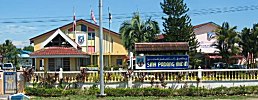
SMKPM in 2003, from this view, minus a few small added structures, including the gate and the fence, and the floras, it is about the same as the view in 1965; obviously a lot of changes must have taken place inside. |
The year 1965. In Jan we all moved completely; Sekolah Menengah Kebangsaan Padang Midin, in Padang Midin, six miles (ca. 10 km - 15 sen bus fare) to the west of Kuala Terengganu (towards Kuala Brang). We were on our own, not a big school though, but 'perfect' with two class-rooms blocks, a hall (those days, a school without a hall would not be let to be used, because a hall was very important for students education - the delayed for our move in 1964 last year was due to the incompletion of the hall), a two-labs block, Head Master Quarter, a roomy canteen (opposite HM quarter), a big field still full of mimosa, a 8-dorms double-storeys boys hostel block (and the dining hall) and several teachers quarters. We had our own uniform, white shirt and
sky-blue short pant,
navy-blue long pant for the prefect (and similar colour of sarung/skirt for the girls). I was a hostel boarder. The girls boarder like
Mariam still squatting in SS though, their hostel building would not be ready in a near year. There was electricity, but piped water was not yet arrived. The water supply for the hostel, the labs and WCs in the school was set up by pumping water from a well digged between the lab block and the hostel, into a big distributory tank above the well, with a complete plumbing throughout the school compound including the teachers quarters which were on the other side of field which was facing the hostels. The entrance gate was fitted with cow-grill, since the area was a farmers area, not as SS which was an elite area. The new intake came in Jan, and for hostel boarders the freshies were boarded in R1 and R2.
 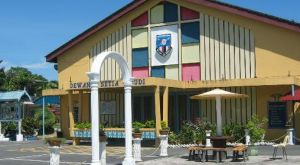
The hall, then and in 2003. It appeared that it had been named: Dewan Setia Budi. CheGu Ishak Haron stood on the flower bed coaching us to sing correct 'Negaraku'. The class blocks are on the left of the pictures, the first, closer to the hall sited the school office, with attched Head Master office, followed by the Staff Room, a WC, and a shedded path connecting the canteen. The other building run in parallel, from the perimeter extending to become the 2-labs block; one lab for life science (kaji hayat [bilogy], and the other physical science (physics and chemistry). CheGu Osman and CheGu Ghazali Haron were the science teachers. |
I was in Form 2A, so did most of my last year classmates, after a routine seiving based on the final year exam in Oct last year (for simplicity, only Bahasa Melayu, English and Ilmu Hisab [math] were examed - others were not). I was very much looking forward to go on. There were six classes of form two, from six classes of form one last years. The class form teacher was CheGu Abdullah, an RTC trainee, and he taught Math. CheGu Wan Khalid, another RTC trainee taught English. I remembered he spent much of the time teaching us "parts of speech" in his too malayness English. I remembered both CheGu Abdullah and CheGu Wan Khalid were "observed" by their respective supervisor in our class. CheGu Hussein, the hostel warden taught us Literature. In a class, we were discussing about MALAYSIA, then was just in the formation, and listening to the word MALAYSIA, Mohd Jusoh (small) [another one was Mohd Jusoh (big)] spontaneously shouted "Melayu mati"; CheGu Hussein was very furious; with his eyes circularly opened behind his thick pair of glasses, he asked Mohd Jusoh to stand on the desk throughout the period [Incidentally both Mohd Jusoh did not survived the A class; before the year end the big Mohd Jusoh quitted the school all together, and the small Mohd Jusoh dropped to B class the following year - we were replenished with two pairs of name-pair: Abdullah Embong (A and B) and Ismail Mohamad (A and B)]. CheGu Ghazali Haron taught Science, CheGu Rahmat Saripan (history), CheGu Rahim Tahir, CheGu Maimunah taught us Ilmu Alam (geog), and CheGu Ibrahim Sihi taught us Civic and PE. CheGu Yahya taught us Art; he seemed to be especially keen in "Bali Painting", the subject he firstly taught us in his art class.
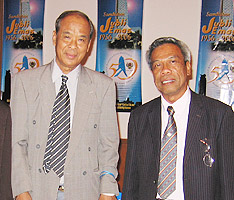 Update 2006 Apr 14 Fri, Dewan Bahasa dan Pustaka. I saw CheGu Ishak several times in a distant; but today, I managed to grab his hand and reopen the "Negaraku"; he loughed aloud like almost closing his eyes. Here I was with Prof Dr Ishak Haron, 40 years later, both attending the launching of EST by the Minister of Education; Update 2006 Apr 14 Fri, Dewan Bahasa dan Pustaka. I saw CheGu Ishak several times in a distant; but today, I managed to grab his hand and reopen the "Negaraku"; he loughed aloud like almost closing his eyes. Here I was with Prof Dr Ishak Haron, 40 years later, both attending the launching of EST by the Minister of Education; |
He came to school in a red two-seater sport car. Other teachers around that I had known was CheGu Mustafa Jar,
CheGu Saadiah and CheGu Rehana, and I only saw the Head Master, CheGu Nordin Nasir this year, although I knew the name since last year; he sometimes I saw was walking upstairs, carrying only his two hands to teach form five (I supposed Composition in Bahasa Melayu). Some 'new' teachers I remembered: CheGu Husin Awang (math - he taught us math before CheGu Abdullah took over - and he told us that the decimal point in a value should be positioned in the middle between the figures, not at the base line as in the full stop), CheGu Nik Rashid Ismail (math), CheGu Badariah, CheGu Subramaniam (English), CheGu Osman (science), CheGu Harun Tahir, CheGu Halim, and CheGu Sulaiman who played guitar. After about one third of the year I remembered we had a new teacher announced by the HM in the assembly: CheGu Ishak Haron; and he was given the task of making all the students to sing Negaraku 'correctly'. In SS last year we never sang "Negaraku", neither did when we moved here in the Oct. For several days from his first day, he assembled us on the front open ground (the site of daily morning assembly before entering the class - Sunday morning assembly was in the hall) to correct our singing; I was not sure whether or not we had sung correctly when he gave up on assembling us after the usual morning assembly.
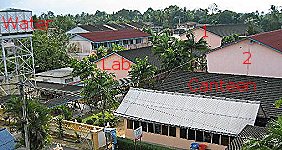 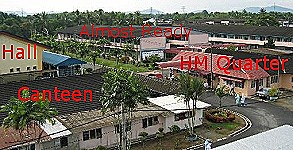
Those days in current matrix: the water tank, The Lab, The Class-room blocks 1 & 2, the Canteen, The Hall, The Head Master Quarter, the two new buildings for Industrial Arts not yet fully equiped for use. The picture were probably taken from the boys hostel high position. Structures other than the marked, were absent in those days; inside the school the flora were only shrubs, but outside were fruits orchard and coconuts. |
Two American peace corps reported duty some times in 1965: Paul
Something and John McCarnacky (wrong spelling). The former taught Math, and advisor to Science and Math Soc (the only functioning society in 1965), he spoke 'better' English, but bad Malay. I was a committee member of the society and the only activity I remembered was a few additional classes of non-conventional math, like set theory, etc (from whom I picked the idea to write
an article for a SAS megazine in 1969). The latter stayed in the school quarter. He taught English, but his spoken English was very 'bad', in fact his Malay was 'better'. He wore sarung pelikat (only down to his knee because he was a very tall person) and a short sleeve shirt all the time in off-school hours in the school compound (perhaps thinking that, that was our natural dress, or perhaps he had just been transferred from Burma). He organised some sort of 'Nature's Club' with the only activity was to overseer the hostel boarders (I was one) to get the mimosa and lalang cut down (using hoes and 'tajak') around his quarter and then turned it to vegetable orchard. I never remembered any harvest from the orchard. There was another volunteer in the school in 1965: John Ingram from Australia. He taught English and his spoken English was even 'worse' than the Americans. He taught us a few times, using the super modern teaching aid of the time: a tape recorder of a 21" TV size and weight. In one class, while he was teaching, he suddenly rushed out of the class, ran down the stairs to the assembly ground towards to gate and out through the gate to the road towards Padang Midin. We were looking in full of suspense. Apparently he was rushing to rescue a motorcyclist who had just caught by a pothole and collided with the small bridge head on the road just outside the school compound; I remembered it was a dark red bike, perhaps a BSA. John's eyes were on the road while he was teaching us (perhaps his natural reaction to our response to his 'very bad' English).
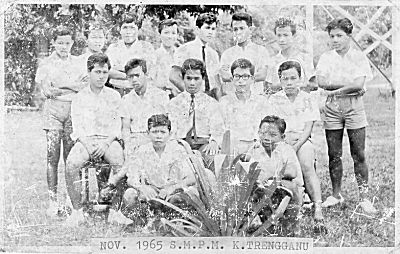
The dorm was a small dorm; the dorm-mates of R3 in late 1965 posing with the background of our water tower setup, facing the foot-path from lab block (left) to the hostel (right): From left, Front row: Mohamad Sulaiman (F2), Md Ariffin Musa (F2); Middle row Abdul Rahman (F4), Mansor Abdul Rahman (F4), Alias Mohamad (F5 - Room head, a hostel prefect), Nordin Abu Bakar (F4), Mat Zakaria (F2); Back row: Razali Yusof (F2), Abdullah Embong (F2), Abdullah Che Din (F2), Anuar Rushdi (F2), Mamat Ibrahim (F5 - Assist Room head), Mohamad Awang (F2), Mohd Shahir (F2) and Ali Yatim (F2) Most of us stayed in this room for two years to 1966. Ali's bed was on my right who was on Alias's left (the wall site - room head). Mohamad Awang's bed was in the opposite rows. Unlike in SS, my bed was 'well-equipped', as the beds of others, but in many ways I was very much behind in many 'accessories', many times I borrowed Mohamad Awang's (leather) shoes to go to town, or for casual wearing.

More of the same boarders. See how nice the room head was, he let me wear his neck-tie; L to R: Mohamad Awang, Mansor, Abdullah, Alias, Ali Yatim, Mat Zakaria, and Abdul Rahman. Hey, I was wearing the trouser. That was my first trouser, tailored in KT for fifteen ringgit.
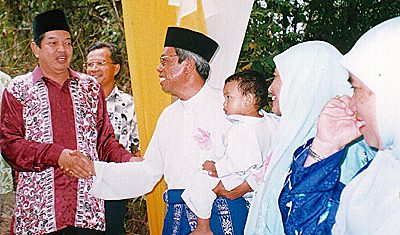
Arif the son of Utz Yusof of Padang Midin Mosque. Heard about him in 1964 in SS, heard again in 1965 and 1966 in Padang Midin, met for the first time in 1976 in Damansara Utama, and came to my home in Aug 2002. |
Only six dorms were occupied in the hostel; four on the top floor, and two ground floor. The remaining ground floor was for recreational room; to 1966 end, it has only one table-tennis table. The warden was
CheGu Hussien Hj Ahmad, and his bachelor quarter was on top floor at the entrance stair. The school fence was only about five feet from the hostel corridor, and outside the fence was the local's rambutan orchard with the branches extended into the hostel compound. Thus in fruit season their fruits were inside our hostel, and it was a hell of a job by the warden and the prefects to stop the temptation of the boarders to pick the fruits. The dining hall was at the back of the hostel; a (manual) copper bell reminded the boarders of meal times (striked by a hostel prefect). The meal in the hostel was better than that of the SS hostel last year, in that they were more of local recipe, and the desert, although no more apple, were a variety of local fruits: papaya, melon, banana, even pineapple; and we came to know that the contractor was Wan D, a local, and the contracts was for the cooked food, unlike in SS where the raw food stuff were contract-supplied and the school cook cooked them. Very happy with everything new in the school, the warden very frequently had his dinner with us in the dining hall (of course with additional made to custom dishes, courtesy of the contractor who delightedly entertained). One could expect such a rosy beginning would gradually rot, and yes as the days went by, it rotted like the fish the contractor supplied rotted. At one point, he had not been seen around the dining hall for many weeks. Nonetheless, there had never been any bad episode in the hostel; the bad food?, well we all came from homes where no food get the time to rot, the 'rotted' foods were made to rot for the recipe required that. The inhabitation around the area was so thin the for Friday prayer, we paraded to Padang Midin Mosque, about a mile further up the road. The people around the mosque were very happy to have us every week. Their locality was basically of local fruits orchards. So in fruit season (rambutan, manggis, langsat, duku, rambai), as always the haves shared their harvest with the have-nots by pooling at the mosque on Friday, feasting after the prayer. We were told by the warden not to hang around the mosque after prayer, so on the first fruit-feast at the mosque when we were re-marching back to the hostel immediately after the prayer, we were actually disappointing the mosque people, and especially so because we were kiddies. On the following week, they 'reacted', they posted several people at the mosque compound outlet so that we could not leave and left with no other than joining the residents feasting on the fruits, and the warden unreluctantly joined. The Imam of the mosque was Utz Yusof, he was an energetic old man, but some of his children were of about my age. At the moment the few years difference was a difference, but many tens years later the difference made no differnce, and later in different places they came to know that I had known their place before they knew me. One was Arif; I had just recalled that a talk of the table in SS in 1964 was about he got a good science results in LCE the year before and had just left for Royal Military College (RMC) in Sungai Besi, Kuala Lumpur. We surely would meet in the future somewhere. His sister, Mukminah, was then unknown to me, but would be in times to come, not because of her brother, but because of my own children, and strengthened by the person I knew when I was a school boy.
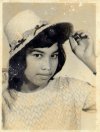 |
I was still very much a boy, unlike many of my class-mates who I saw were transforming into teen-agers, especially the girls. With Hashim gone, I did not remembered I had a friend to whom I could confess; so far the fellow FMS recipients in the class were purely bonded by the three-monthly call to queue in front of the school office (manned by a clerk and a typist, both males) to collect our substance. Nonetheless, I noticed a very talkative and attractive class-mate who did not mind talking to me. She was Azizah Muhamad from a rather well to do family in Seberang Marang, as I found out. Hidden behind her beauty was her destiny that very soon she was leaving us too, but for the reason very different from that of Hashim. She said she was getting married, and to a YB living in her place. She was prepared, I observed, and she did not shed a drop of good-bye tears to us on the last day she was in Padang Midin, before Jan ended. On the portrait she gave to me (and to many others) she wrote, "my shadow for your memory" which she understood very well, but took me twenty years to understand. I had not heard about her since then. Following Azizah steps was another class-mate, also a girl named Munah. I was very sad for the reason she was quitting. Moneyless, and not brainless. Incidently my class was Form 2A, the top of the six classes, and Munah, quiet and not extremely pretty though, perhaps was built from seventy-five percent grey matter inside her rather skinny body and slender which cover the bones. The scenario was my precursor, when four years later, my sister Mek Maziah had no alternative but to repeat exactly Munah's play for my mother and for exactly the same reason, but in Sekolah Menengah Seberang Takir. My heart was yelling in pain then shatterred into pieces because I could not do anything to help, and no one I could cry for help.
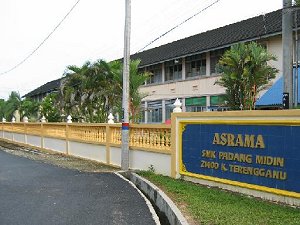
The boys hostel (asrama putra) 'back' (in 2003, no fence and gate then), at the end of the path from the lab block (canteen on the right of the path, water tower on the right); and facing the sports field. At the end of the block was the dining hall, and to the left along the field, on the right side were the teachers quarters. The front of the hostel was facing the school compound fence bordering the locals' rambutan orchard. |
The school's and hostel's law and order were very much in the making in 1965. Students' activities were in the foundation and in the skeleton to forming a culture. But as early as May, the school (with CheGu Ibrahim Sihi coaching) had established a frightening rugby team. We won in every friendly games (one game with SS, 21-0). The skinner players (all were rural folks) apparently had harder bones than the fatter opponents from the elite schools, and there was only one Malay Medium secondary school aboded by the skinner students throughout Terengganu: us; or perhaps rugby was a very much lawless game compared to football which was also to our advantage. But we always lost badly in the netball. Our girls still needed more exposure. CheGu Rehana formed a choir team, in proactive steps warned by the HM that many celebrations would be raining down on the school very soon. The sport Houses were named: Merewah (red), Perani (yellow), Chelak (green) and Palawan (blue) (the four Daing's in the Cerita Melayu). I was in Merewah, and our House Master was CheGu Osman (science teacher). On the sports Day, CheGu Osman used his own money to buy food (it was sandwich and orange juice) for all the students (in other Houses, a collection was made - a house fee - from every member students). My fellow 'house-mate', Wahab, a form-four, was the cross country runner. The school set the route (passing the real country - not as in SS where the route was mostly the beach) and the pace based on Wahab's stamina. The X-country day (final week of first term) commenced from Padang Midin Primary school, about a mile away, because they have bigger field to accomodate the stampeding start and passing a very short trunk-road before entring the no-car country route, comming out at Pengadang Baru, and finished in our school field. I was very bad at sports, I was in the tailing sporadics, in fact I never knew whether or not I was in the correct route, and when I arrived, the field was beginning to unswell, and I never knew whether or not I contributed any point to my house.
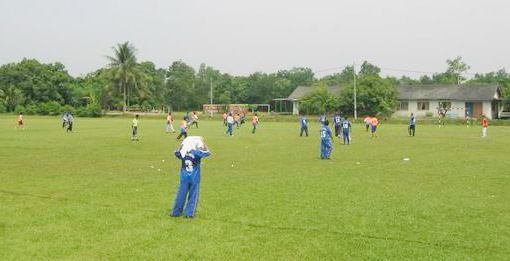
The school field in 2005; teachers quarters in the background. It was mimosa-infested in 1965; |
We were deprived of many supportive facilities. The school bookshop sold only books. There was only one shop, a cofee-shop just outside the school (perhaps opened purposedly to cater the workers who built the school). The nearest sundry shop was in Pengadang Baru, about a mile downward, but for students need of more equiped sundry shops, it was in Bukit Payong, two miles upward. Otherwise one has to take the infrequent bus trip to Kuala Terengganu. As in 1964 in SS, I never fall unwell, but I cycled twice to Bukit Payong clinic (borrowed Kamariah Ali's bicycle) to have my molar extracted. On normal day, I started my day on the field right after lunch in the hostel, as early as half-past two through to seven in the evening, the dinner bell, every day including rainy day. Bakar, a form 2 senior, organised the 'play', to the extent that he pooled some money from friends to buy our own football, it was more of a stempede football. Prep class was not held in the afternoon, but after dinner, to ten we had our prep class in the recreation room.

The minister of Education was the guest of honour; |
|
SMPM was officially opened on Tuesday, September 28, by the Minister of Education, YB En Mohd Khir Johari. The first students non-physical activity was also held on the day: the very raw stage show. A new name for the school was proposed during the occasion: Sekolah Menengah Dato' Amar aka Sekolah Dato Amar. The name maintained for about a year with many stationery were already printed with the name, including the badge (logo) printed in official documents including leaving certs. It was then contended that Dato Amar was not the name of a honorable person, but was a post - Chief Minister of Terengganu. I learned that after 1966 when I had left the school, its name was reverted to its locality-based name, the policy prevailing beginning at the time.
 I had an anecdote with the hostel warden, CheGu Hussein Ahmad. It was early Friday morning in April when I woke him up to tell him that I was leaving the hostel to commute to school by bicycle; my childish and foolish decision. My intention was to own a bicycle, the transport which I thought would take me anywhere in the world, the way I saw my friends would be. The model was Abdul Rahman who came from near Kuala Bekah; he had a bicycle and stayed in the hostel. I could not have both like him; it was impossible. I told this to my mother the weekend before (to quit hostel and to commute to school from home), and she did not disagree. In fact I had given her quite a trouble already for very soon she asked Abang Wi to search for a second-hand bicycle, affordable, about 30 to 40 RM; we had seen one in Pengkalan Batu. And I had taken home some of the bedding staff. I told CheGu Hussein my intention, hiding my real intention, telling him only that it was due to my financial "status quo". He knew that I was a FMS recepient. He was not happy. He gave me a twenty minutes lecture, still in his night dress, and on the twenty-first minute I changed my mind. I owed him that short Friday morning 'sermon' which many years later I take as the God's detail implementation to protect my destiny. My fate and destiny "changed" my routine, beginning after that. I woke up to discover that reading books stimulate a lot of thinking skill, a lot more than the ball dribbling skill on the mimosa-infested field. The ever-nice smell of new books actually was a condiment while one dribbles the words, equations, graphs, diagrams, etc. in the books. One can stay late at night with the books, but not with the ball, and the most important piece of discovery that made me submitted to my destiny was that it does not cost money to be skillful with the books, as compared to the costly hardwares needed to be skillful in footballing, or in any other games. This piece of discovery is very atractive to me indeed.
I had an anecdote with the hostel warden, CheGu Hussein Ahmad. It was early Friday morning in April when I woke him up to tell him that I was leaving the hostel to commute to school by bicycle; my childish and foolish decision. My intention was to own a bicycle, the transport which I thought would take me anywhere in the world, the way I saw my friends would be. The model was Abdul Rahman who came from near Kuala Bekah; he had a bicycle and stayed in the hostel. I could not have both like him; it was impossible. I told this to my mother the weekend before (to quit hostel and to commute to school from home), and she did not disagree. In fact I had given her quite a trouble already for very soon she asked Abang Wi to search for a second-hand bicycle, affordable, about 30 to 40 RM; we had seen one in Pengkalan Batu. And I had taken home some of the bedding staff. I told CheGu Hussein my intention, hiding my real intention, telling him only that it was due to my financial "status quo". He knew that I was a FMS recepient. He was not happy. He gave me a twenty minutes lecture, still in his night dress, and on the twenty-first minute I changed my mind. I owed him that short Friday morning 'sermon' which many years later I take as the God's detail implementation to protect my destiny. My fate and destiny "changed" my routine, beginning after that. I woke up to discover that reading books stimulate a lot of thinking skill, a lot more than the ball dribbling skill on the mimosa-infested field. The ever-nice smell of new books actually was a condiment while one dribbles the words, equations, graphs, diagrams, etc. in the books. One can stay late at night with the books, but not with the ball, and the most important piece of discovery that made me submitted to my destiny was that it does not cost money to be skillful with the books, as compared to the costly hardwares needed to be skillful in footballing, or in any other games. This piece of discovery is very atractive to me indeed.
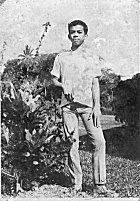
Mohd Nor Hassan, the brother of CheGu Halim. |
By the close of the year, I had forgotten how to kick a football, but I was befriended by many form four seniors in the hostel because I sometimes participate in their math problems solving. Nordin was one of them. He studied hard, but rather slow in math. In particular was Md Nor Hasan, a younger brother of CheGu Halim, the form five BM teacher. He stayed in the hostel despite his home was only in Tanjung and his brother CheGu Halim, with whom he lived, commuted every day in his car. I was quite close with him for sometimes through to the following year where we were equally busy to prepare for our exam. I went to KT many times with him, and he showed me several places in KT around Tanjung, his locality. One Saturday afternoon, Md Nor took me to his house. Relaxing after the meal, my eyes caught a typewriter machine on the table - the kind of thing which in those day I could only dream to even use one. But on that day CheGu Halim let me use his typewriter, and he in fact taught me how to control all the gears on the machine, and for the first time I could see my writings 'printed' in beautiful letters.
My mother visited me once in the hostel; the only time she visited me, in fact the only visitor I had throughout tree years my hostel-life in 1964-1966. She came with my little sister Rubaihah. It was on a late morning Sat; she did not stayed long. She brought with her for me two pieces of fried chicken she said my father cut the day before. She told me that I probably had a not too distant paternal relative studying with me here in the school. She was a girl who had moved with her father to Bukit Besi. She was Mariam, but at that time it did not matter so much to me, I have already had my close cousins Ahmad Yusof and Nawi MakDa.

The flood, in the street of Kedai Payang; (pic courtesy of Awang Goneng)
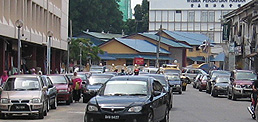
The same street in 2006 jun; the clock had been removed; the background had been added with building, but the 'surau' in the middle of the picture is in peace with an added front section; the market stalls on the left had been renovated; the shops on the right is there in the original piece. |
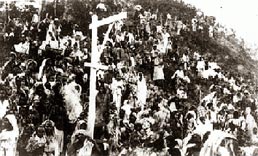
And in the "red-water" flood (ca. 1926), the people found their santuary on the hilly places; (pic courtesy of Awang Goneng) |
Monsoon had been riding high in these few years, the rain came as early as september, but by the time the flood was coming, we all had gone home for the final break in Nov middle. The rain was really mad this year. It brought a lot of rain, and it was a festival of water for Nov to Dec. At about end of Dec, I was at home with all the family members, the sky was gloomy most of the day, the rain fall, heavy, intermittent with lightly and drizzle; and a flood rushed to our place (throughout east coast); the rain water swelled the river to joined the high tide of sea water. People's padi and shrub orchards were demaged. In front of my home for the first time I remembered the river water crossed the road to the padi side. The water kept on flowing, it rose up from a foot to many feets in two days. A red flag was risen at the mosque on a tall bamboo pole by the village head Raja Ali, signalling the danger level had been reached and the parents must take extra precaution to their children. Relief centre was set up at
Bukit Tunggal Primary School, and those who felt insecure should move to the relief centre immediately. Boats belonging to the people were pooled for the ferrying purposes where necessary (fortunately, the trunk road was not sunk, but the Losong jetty boats interupted its sevices many times because the current was so strong - ferry sevices had been closed a few years ago when the new road via Manir was opened). Livestocks had already been moved to higher ground in 'Banggol' many days before. Bicycles, perishable items kept under the house had already been up in the house; the chicken knew to get up by themselves and occupied a corner at the 'balcony' in the kitchen section. Several instances my mother was tempted to move to the relief centre, especially in the light that the food was served at the centre, and the food at home was only the stocked food. It was Ramadan, one late evening, and the water was rising, but the current was rather slow (indicating that it had almost reached the level in all places), already close to the floor of our house; standing on the ground it was at my father chest. My father did not worry about me and my brother because he knew that we could swim 'profesionally' in such water. My mother made a decision: MOVE!. Our nearest neighbours had not moved yet, perhaps because they would lost more if they do. When my mother was packing, Mek Bunga, the front neighbour was watching, her house was much higher than us. She offered to put up for the night in his home; if water still rise by morning, then we all would move together. So, my mother moved to Mek Bunga's house, taking my younger brother and two sisters. My elder brother and me tagged closely around my father. I slept with my mother, but my brother slept with my father at home. The next day I swam home quickly to my father and watched around for the next move to react to the next development. As we were sitting on the 'selasar' (verandah), we were watching the slippers dancing to the ripple of water surface on the 'lambor'. We were watching, and watching, and... and the slippers were slowing and finally stopped dancing. The water surface was on the level then below the 'lambor'. The water was sunsiding, the flood was subsiding, and all of us were relieved. My mother moved back to our house, and we were watching the water subsiding, firstly slowly, then rushing in speed, ironically in the same direction, and in two days all ground around our home were muddy red. It was a very wet end of the year.

Edition dated May 2003.
![]()
![]()




 Update 2006 Apr 14 Fri, Dewan Bahasa dan Pustaka. I saw CheGu Ishak several times in a distant; but today, I managed to grab his hand and reopen the "Negaraku"; he loughed aloud like almost closing his eyes. Here I was with Prof Dr Ishak Haron, 40 years later, both attending the launching of EST by the Minister of Education;
Update 2006 Apr 14 Fri, Dewan Bahasa dan Pustaka. I saw CheGu Ishak several times in a distant; but today, I managed to grab his hand and reopen the "Negaraku"; he loughed aloud like almost closing his eyes. Here I was with Prof Dr Ishak Haron, 40 years later, both attending the launching of EST by the Minister of Education;








 I had an anecdote with the hostel warden, CheGu Hussein Ahmad. It was early Friday morning in April when I woke him up to tell him that I was leaving the hostel to commute to school by bicycle; my childish and foolish decision. My intention was to own a bicycle, the transport which I thought would take me anywhere in the world, the way I saw my friends would be. The model was Abdul Rahman who came from near Kuala Bekah; he had a bicycle and stayed in the hostel. I could not have both like him; it was impossible. I told this to my mother the weekend before (to quit hostel and to commute to school from home), and she did not disagree. In fact I had given her quite a trouble already for very soon she asked Abang Wi to search for a second-hand bicycle, affordable, about 30 to 40 RM; we had seen one in Pengkalan Batu. And I had taken home some of the bedding staff. I told CheGu Hussein my intention, hiding my real intention, telling him only that it was due to my financial "status quo". He knew that I was a FMS recepient. He was not happy. He gave me a twenty minutes lecture, still in his night dress, and on the twenty-first minute I changed my mind. I owed him that short Friday morning 'sermon' which many years later I take as the God's detail implementation to protect my destiny. My fate and destiny "changed" my routine, beginning after that. I woke up to discover that reading books stimulate a lot of thinking skill, a lot more than the ball dribbling skill on the mimosa-infested field. The ever-nice smell of new books actually was a condiment while one dribbles the words, equations, graphs, diagrams, etc. in the books. One can stay late at night with the books, but not with the ball, and the most important piece of discovery that made me submitted to my destiny was that it does not cost money to be skillful with the books, as compared to the costly hardwares needed to be skillful in footballing, or in any other games. This piece of discovery is very atractive to me indeed.
I had an anecdote with the hostel warden, CheGu Hussein Ahmad. It was early Friday morning in April when I woke him up to tell him that I was leaving the hostel to commute to school by bicycle; my childish and foolish decision. My intention was to own a bicycle, the transport which I thought would take me anywhere in the world, the way I saw my friends would be. The model was Abdul Rahman who came from near Kuala Bekah; he had a bicycle and stayed in the hostel. I could not have both like him; it was impossible. I told this to my mother the weekend before (to quit hostel and to commute to school from home), and she did not disagree. In fact I had given her quite a trouble already for very soon she asked Abang Wi to search for a second-hand bicycle, affordable, about 30 to 40 RM; we had seen one in Pengkalan Batu. And I had taken home some of the bedding staff. I told CheGu Hussein my intention, hiding my real intention, telling him only that it was due to my financial "status quo". He knew that I was a FMS recepient. He was not happy. He gave me a twenty minutes lecture, still in his night dress, and on the twenty-first minute I changed my mind. I owed him that short Friday morning 'sermon' which many years later I take as the God's detail implementation to protect my destiny. My fate and destiny "changed" my routine, beginning after that. I woke up to discover that reading books stimulate a lot of thinking skill, a lot more than the ball dribbling skill on the mimosa-infested field. The ever-nice smell of new books actually was a condiment while one dribbles the words, equations, graphs, diagrams, etc. in the books. One can stay late at night with the books, but not with the ball, and the most important piece of discovery that made me submitted to my destiny was that it does not cost money to be skillful with the books, as compared to the costly hardwares needed to be skillful in footballing, or in any other games. This piece of discovery is very atractive to me indeed.


